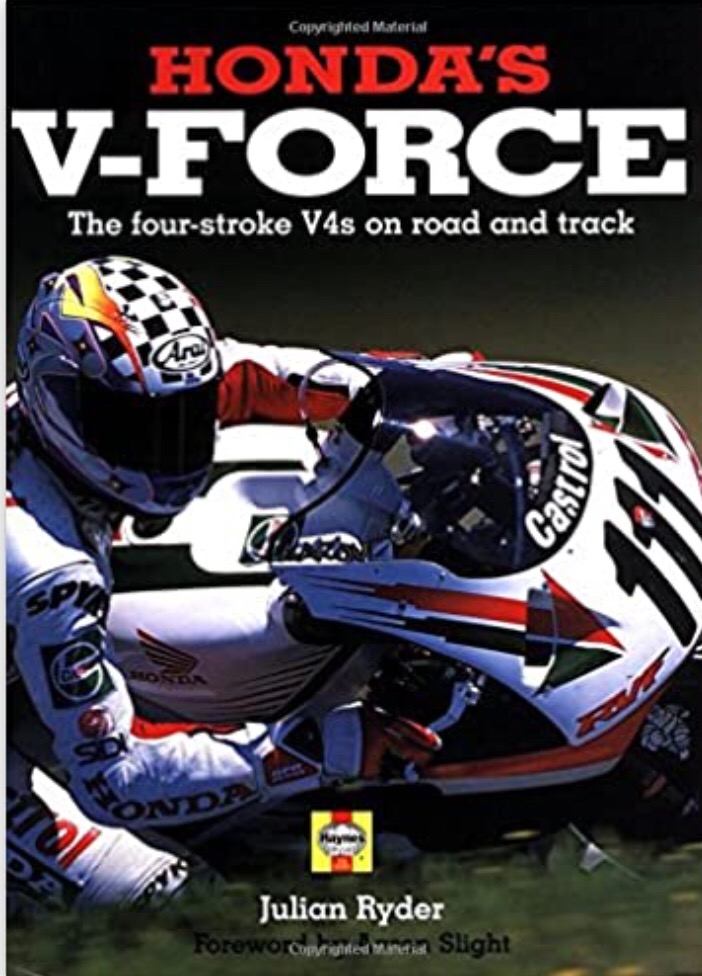
A few years ago upon someone's suggestion I read Julian Ryder's 1999 Honda's V-Force, subtitled Their four-stroke V4s on road and track. An enjoyable read, nicely illustrated and well-written, and containing many interesting observations and insights. It's rewardingly engaging. I actually found a lot to like in the content covering the first-generation production bikes. I particularly like his description of Honda V4 engine power as "seamless".
I did however stumble over one or two things Ryder said about the technical aspects of the early production bikes, especially that in Chapter 4.
VF500F crankshaft recall
Ryder doesn't mention that the VF500F crankshaft issue was in fact a recall, meaning that it had serious safety implications. It should be noted that the recall, which involved replacement of the whole engine, was preemptive. The crankshaft flywheels cracked under sustained top speed use on the autobahn, which was almost academic in the U.S. The replacement engines came inside wood crates with foam rubber balls in their intake and exhaust ports. Whole engine replacement was rare for Honda, who like most manufacturers would rather have replaced the crankshafts but was likely pressured into more immediate action by the Euro press.
Oil banjo bolt
The oil banjo bolt thing is apochryphal. I was there, both at the corporate office and also at the dealerships, when these bikes were introduced and were current models. The shaft drive (Sabre, Magna) and chain drive (Interceptor) bikes have different oil banjo bolts. They were different because on one bike the oil goes to the right angle drive, requiring a change in pressure. The chain drive bike didn't have this oiling need. However, some wise guy noticed the difference between the two bolts and began spreading the idea that replacing the jetted bolt for the non-jetted was a good field fix for supposedly oil-starved cams. However, oiling had nothing to do with the cam issues, thus changing the banjo bolt is ineffective.
V4 design runs hot, contributes to cam failures
Honda V4 engines didn't run excessively hot, surely not as hot as the CBX1000 model Honda. Heat had nothing to do with it. Lubrication had nothing to do with it. The phases of the moon had nothing to do with it...
Bad cam chain tensioners as a cause of cam failures
This is actually funny. How could the two be related? The tensioners on most first-gen models were revised at least once due to their backing off tension, resulting in annoying chain rattle. Even the replacements eventually fail. But there is no connection between that and cam failure.
Final solution the special valve adjustment tool
Let's cut to the chase. Honda themselves changed their mind about this tool, as Ryder dutifully and surprisingly mentions. The whole cam tool thing was corporate coverup, and part of a blame game perpetrated on their dealers. I've written elsewhere on my website about this.
Honda's replacement of the early production run 1982 cams and bearings
The first year cam bearings were looser than all the later ones, resulting in a fairly deep-seated top end rattle that could not be eliminated by valve adjustment, though many tried by using tighter than specified valve clearances. Dealer mechanics actually sanded the bearings down to tighten them somewhat, which was very effective and not at all sketchy given Honda's penchant for 0.005" to 0.010" production cam bearing clearances on all their engines. The DOHC inline four racers do the same thing. There never was a program involving this kit and it's surprising Julian knew about it. I show pictures of it on my website. Specially heat-treated cams, but more importantly, tighter 1983 cam bearings. The 1983 heads also were modified with increased bearing saddle area and the factory actually gave a few of these heads away in 1982 to solve noise complaints. But the kit was never publicized and required the dealer to interact directly with Honda's technical department.
My motivation here is correct information. I don't mean to defame or put down. It is good to see someone celebrate this period in Honda's history. I just wish they would be a little more focused on fact.

 ®
®
